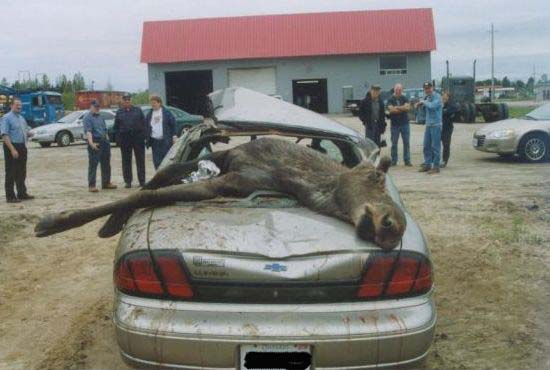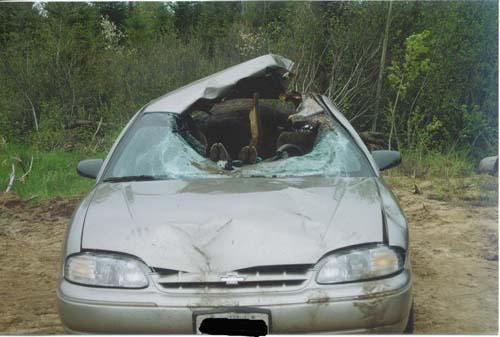Moose can be
dangerous - to drivers

With thanks to New Hampshire Fish and Game Department’s Moose Project Leader, Kristine Rines, and those biologists before her, New Hampshire’s moose population has increased well over the years. According to Kristine, our moose herd is estimated to be 6,000 animals strong.
Moose are wonderfully majestic animals to view. Seeing them provides people in New Hampshire with a wonderful and exciting experience. However, moose can and do provide a dangerous situation, especially at night, for the unobserving and careless driver on our New Hampshire roadways.
According to our Fish and Game Department, there were 198 moose/vehicle collisions in the state during 2007. In the last five years, the state averaged 230 collisions with moose per year. Kristine Rines says, "The months of May and June are high-risk months for encountering moose on all types of roadways, because moose are moving from winter and spring habitats and starting to come out on the roads to eat salt. Moose are an important and much loved animal of our state, but it can be dangerous to encounter them on the road. By following a few simple rules, motorists can greatly reduce their chances of a moose/vehicle collision and/or the severity of personal injury if they do hit a moose."


It was about five or six years ago that there was a moose/vehicle collision on Route 114, just above the intersection of Route 114 and 114A in Pinardville. Although the colliding vehicle was badly damaged, it was fortunate that the occupants were not injured. The Goffstown Police had to put the moose down by shooting it. The thing that amazes me is how some drivers act so careless while driving at night. They drive too fast and often with their lights turned down to low beam. Moose stand high, are dark brown colored and hard to see against pavement at night, especially if they come onto the roadway from forage bordering the road. There are moose in Goffstown areas and they do travel. When driving on New Hampshire roadways, especially at dusk, night or in foggy weather, New Hampshire Fish and Game Department makes these suggestions:
-
Moose/vehicle collisions happen most often from the months of May through November.
-
At night, don’t depend on "eye shine" to alert you to a moose’s presence. Moose don’t always
look at an approaching vehicle.
-
To reduce the chance of a collision, or the severity of occupant injury if you do hit a moose:
-
Drive no faster than 55 m.p.h. and wear your seat belt.
-
Keep your headlights on high beam whenever possible.
-
Scan both sides of the roadway as you travel.
-
Be able to stop within the zone of your headlights.
-
If you see a moose, slow down immediately, or stop if necessary, until you have passed it or it has left the road.
Moose/vehicle collisions can be very catastrophic so caution pays dividends. If you are traveling at night, dusk or in heavy fog and the speed limit is 65, drop down to 55. It is unfortunate that so many drivers travel highways at speeds of 15 to 20 m.p.h. faster than the limit calls for. So, be cautious and stay safe.

Bob Harris can be
reached via e-mail at:
outwriter2@aol.com
Past
Columns by Bob Harris
>>>
About
Bob Harris
>>>
DISCLAIMER: The opinions
expressed by Mr. Harris are not necessarily those of the
Goffstown Residents Association or its members
Copyright©2010 Goffstown Residents Association. All Rights Reserved. |





